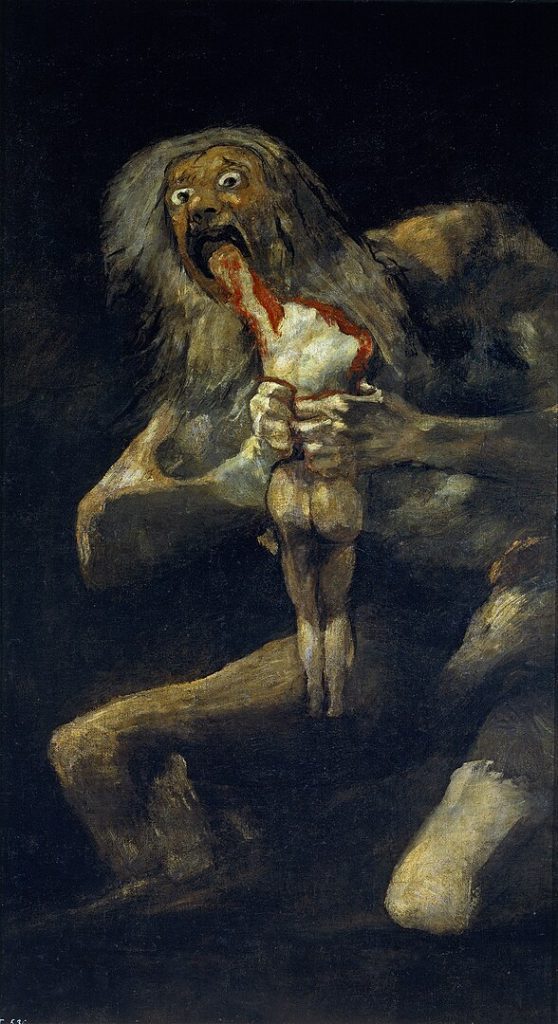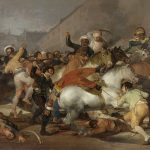
Francisco Goya, one of Spain’s most celebrated artists, left an indelible mark on art history with his vivid imagination and raw emotional expression. Among his most iconic works is Saturn Devouring His Son, a grotesque and unsettling painting that has captivated and disturbed viewers for generations. The piece depicts the Roman god Saturn consuming one of his children in a desperate attempt to thwart prophecy. This article delves deep into the painting’s sinister meaning, exploring its historical context, Goya’s personal struggles, and the broader themes of power and paranoia that it evokes.
The visual intensity of Saturn Devouring His Son is both a testament to Goya’s mastery and a window into his tormented psyche. Painted during the later years of his life, when Goya was isolated and disillusioned, this artwork is part of his Black Paintings series. These paintings reflect a period of profound introspection and despair, contrasting sharply with the earlier, more optimistic phases of his career. By analyzing the painting’s mythological roots, symbolic nuances, and cultural impact, we uncover its lasting significance and its chilling commentary on human nature.
Goya’s ability to evoke such visceral reactions through his work has made Saturn Devouring His Son a focal point for art historians and psychologists alike. The painting’s grotesque imagery and haunting themes remain as relevant today as when they were created. As we journey into the depths of this masterpiece, we’ll uncover the fears, anxieties, and truths that continue to resonate through Goya’s dark vision.
Francisco Goya: A Life of Light and Darkness
Francisco Goya was born on March 30, 1746, in Fuendetodos, Spain, into a modest family. His father was a gilder, and his mother hailed from a minor aristocratic background. From an early age, Goya demonstrated remarkable artistic talent, eventually studying under José Luzán in Zaragoza. His early works showcased a vibrant and lively style that earned him recognition and set the stage for his future as one of Spain’s foremost painters.
Goya’s career flourished as he became a court painter for King Charles IV of Spain in the late 18th century. His portraits of the Spanish elite combined technical brilliance with an uncanny ability to capture his subjects’ personalities. However, the turbulence of Spain’s political landscape began to influence Goya’s work, leading to a darker and more introspective style. His personal life was equally tumultuous, marked by the loss of several children and a mysterious illness that left him deaf in 1793.
In his later years, Goya retreated from public life, seeking solace in his Quinta del Sordo (House of the Deaf Man). This period saw the creation of his Black Paintings, a series of intensely personal and haunting works painted directly onto the walls of his home. These paintings, including Saturn Devouring His Son, reflect Goya’s disillusionment with humanity, his struggles with illness, and the horrors of war. His death on April 16, 1828, marked the end of a remarkable journey, leaving behind a legacy that continues to inspire and challenge viewers.
The Myth of Saturn: A Dark Allegory
The myth of Saturn, or Cronus in Greek mythology, is one of power, prophecy, and betrayal. Saturn, fearing a prophecy that his children would overthrow him, consumed each of them at birth. However, his wife, Rhea, saved their youngest child, Jupiter (Zeus), by hiding him and deceiving Saturn with a stone wrapped in swaddling cloth. This myth is a potent allegory for the destructive cycles of power, fear, and the lengths individuals will go to maintain control.
In Roman mythology, Saturn was associated with time and decay, themes that align closely with Goya’s portrayal. The act of devouring his children reflects not only the fear of losing power but also the inevitability of time consuming all things. Goya’s depiction amplifies this sense of dread, presenting Saturn as a monstrous figure driven by primal urges and paranoia. The myth, through its timeless themes, resonates with universal fears of mortality and loss.
The allegory of Saturn extends beyond mythology, often serving as a critique of authoritarianism and unchecked ambition. Artists and writers have used this story to explore the psychological and societal consequences of power wielded without accountability. Goya’s Saturn Devouring His Son transforms this allegory into a visceral representation of human vulnerability, capturing the terror and futility of such destructive impulses.
The Creation of the Black Paintings
Goya’s Black Paintings emerged during one of the most tumultuous periods of his life, reflecting the artist’s inner turmoil and disillusionment. Painted between 1819 and 1823, these works adorned the walls of his home and were never intended for public display. The series includes Saturn Devouring His Son, along with 13 other works filled with dark, haunting imagery. This period coincided with Goya’s retreat from society and his deteriorating physical and mental health.
The techniques Goya used for the Black Paintings were as unorthodox as their themes. Working directly onto plaster walls, he employed a muted, almost monochromatic palette dominated by blacks, browns, and ochres. His brushwork was loose and expressive, heightening the emotional intensity of the scenes. The result was a series of paintings that felt raw, unpolished, and deeply personal, contrasting sharply with the polished portraits of his earlier career.
Political upheaval in Spain also influenced the Black Paintings, with Goya grappling with the horrors of the Peninsular War and the oppressive regime of King Ferdinand VII. These works reflect his disdain for humanity’s darker tendencies, capturing the despair and chaos of his time. Saturn Devouring His Son epitomizes this blend of personal and political anguish, standing as a testament to Goya’s unflinching exploration of human suffering.
Analyzing Saturn Devouring His Son
Goya’s Saturn Devouring His Son is a masterful combination of horror and symbolism, rendered with haunting intensity. The painting depicts Saturn, eyes wide with terror, violently devouring one of his children. The grotesque details, such as the child’s lifeless body and the blood-stained hands, heighten the emotional impact. The use of stark contrasts between light and shadow amplifies the drama, drawing viewers into the scene’s macabre horror.
Symbolically, the painting reflects themes of power, greed, and self-destruction. Saturn’s act of consuming his child can be interpreted as a metaphor for the cyclical nature of tyranny and the fear of losing control. It also echoes Goya’s personal fears—his isolation, illness, and disillusionment with the corrupt political systems of his time. The painting thus serves as both an allegorical warning and a deeply personal confession.
The raw, visceral emotion of Saturn Devouring His Son has made it a subject of enduring fascination and debate. Art historians have interpreted it as a critique of authoritarian rule, a reflection of Goya’s inner demons, and even a premonition of the modern era’s existential anxieties. Its unsettling power lies in its ability to confront viewers with their own fears and the darker aspects of human nature.
Key Takeaways
- Goya’s Saturn Devouring His Son reflects personal fears and societal critique.
- The painting’s grotesque imagery symbolizes power, paranoia, and destruction.
- Goya’s Black Paintings were created during his most isolated and disillusioned years.
- Psychological analyses reveal deeper meanings in the painting’s disturbing themes.
- Saturn Devouring His Son continues to inspire and haunt modern audiences.




